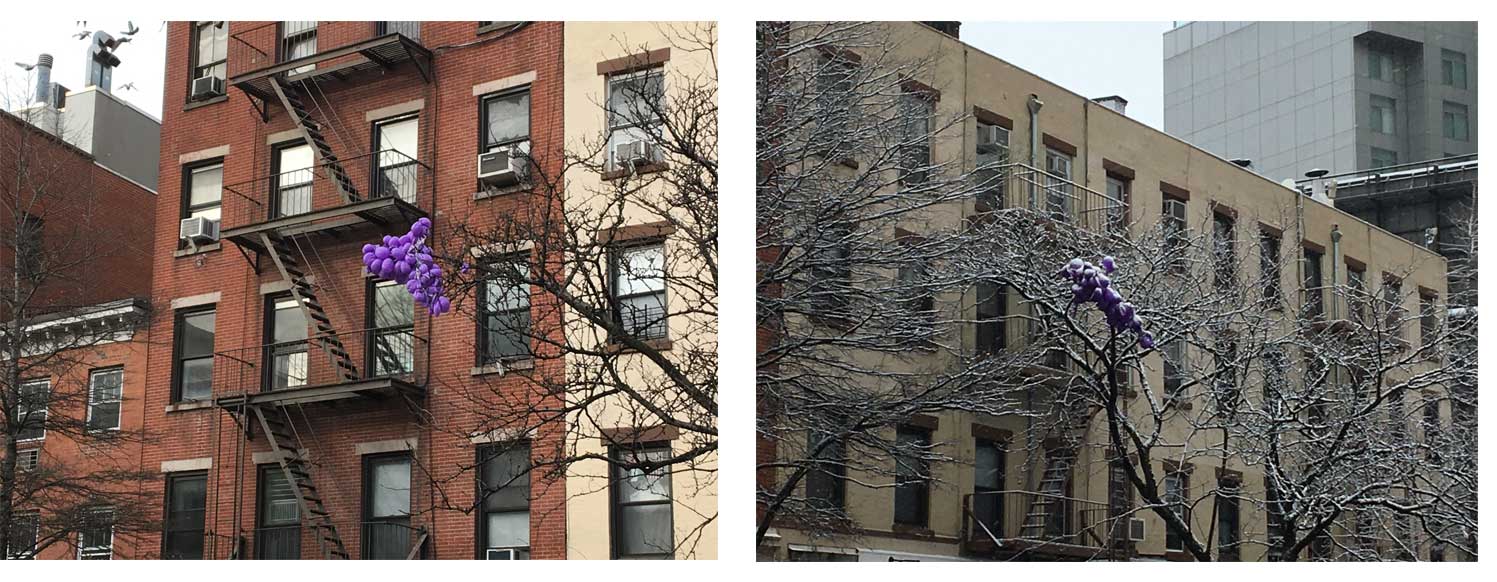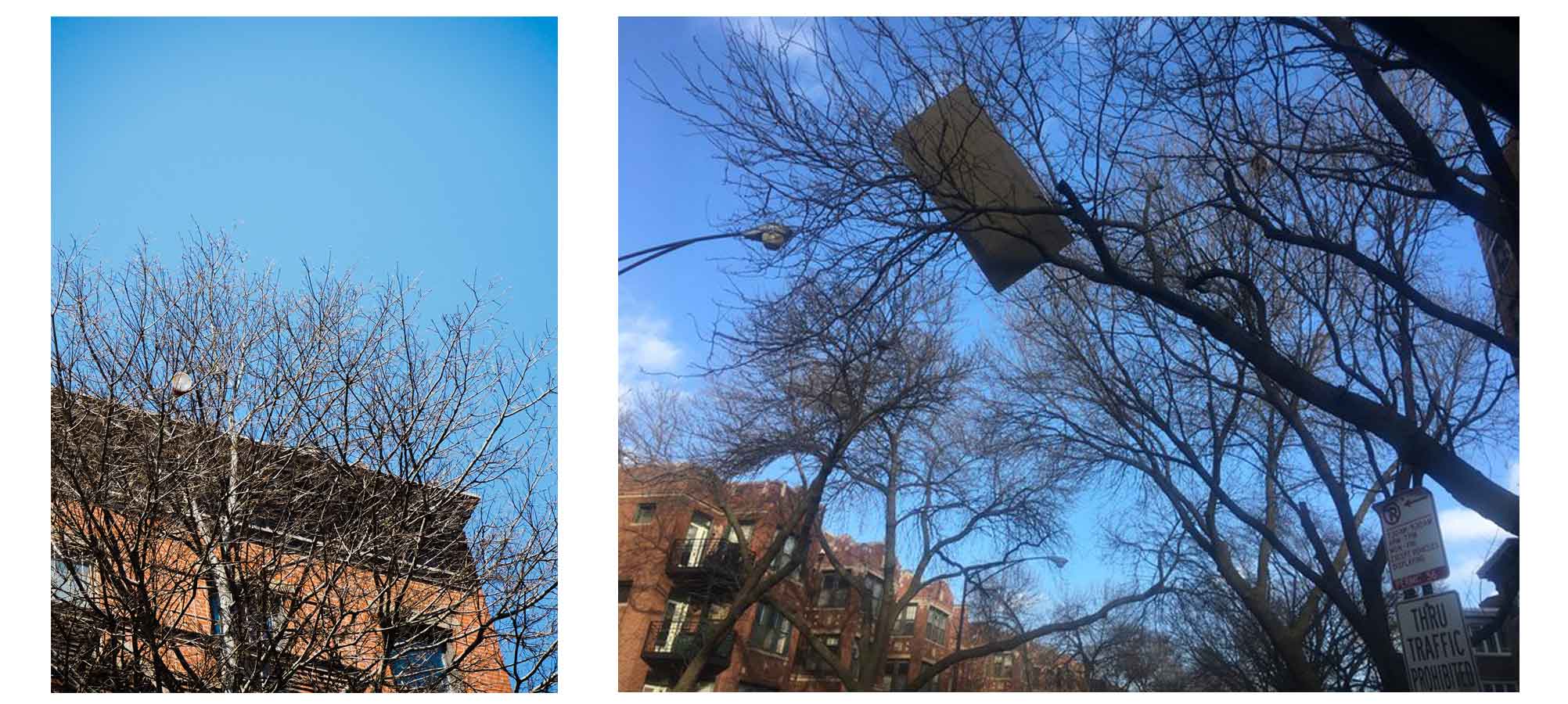On 8 January 2018, I noticed a large bunch of purple balloons in a tree near my apartment building. I know this was the date because it is the day my children returned to school after the winter break, and the tree in question is one we pass on our walk to the subway. I’ve described it as a ‘bunch’ and so you may be picturing the traditional, upright arrangement featured, for example, in the movie Up. If you are picturing that, I appreciate your sense of scale, but the shape is wrong. This was a very large arch, perhaps six feet across, though accurate measurement was impossible from the ground as the balloons were stuck between the third and fourth stories of the building behind it. Many white and silver party ribbons were attached to either end and so my guess, given the time of year and the color scheme, is that it was a decoration loose from a New Year’s Eve celebration somewhere nearby.
The six-foot purple balloon arch was one of the largest things I’d ever seen stuck in a tree, and I was pretty sure it would dislodge itself, one way or another, soon.
It didn’t.
During the weeks when the balloons still loudly bumped around in the wind, I would stand beneath the tree to see if anyone walking by noticed them. No one did. It seemed everyone was busy with a small child or on their phone. So as the balloons wilted from shiny and bouncy to something darker and more sinister, I began taking pictures of them. Not every day, but often, usually on my way home after dropping off my children. I had to stand in front of a small cafe to do this, or across the street near an urban park. Once I stood on a construction barrier in the street.
I thought someone might ask what I was doing, and I imagined the sense of dismay this person and I would share when I explained that the very large purple balloon arch stuck in that tree – Oh, you haven’t noticed? It’s been there three months! – would probably now be there forever. But no one asked me.
I suppose I’ve been noticing things in trees since May 1993. That is the month I graduated from college and moved to New York City. It is also the month Ian Frazier published the first of his ‘Bags in Trees’ essays in the New Yorker, though the first had the broader, more visceral title, ‘Stuck in Trees’.
By May 1994, Mr Frazier and his friends, all of them originally from the Midwest, had developed the ‘snagger’ and were spending weekends clearing trees of plastic bags (‘Bags in Trees II’). I was still a lowly publishing assistant. But I was also a transplanted Midwesterner, and I took heart in our geographical kinship and hoped it meant that I, too, was destined for greater things.
I left New York City in 1995 but moved back in 2007, and it was immediately obvious that Mr Frazier and his by then patented snagger had not solved the debris-in-trees problem. If anything, it was worse. Here is a list of the most common items I’ve seen in addition to plastic bags: shoes, men’s ties, tarps, balloons and umbrellas.
And here are two of the most unusual: a door and a coffee cup. To be fair, the door was not in New York, it was in a tree in Chicago (the writer Allison Lynn alerted me to it).
The difference between Mr Frazier in 1993 and me is that I have Instagram. He and his friends invented a tool and tried to do something productive with it. I just take pictures. In the age of social media, taking pictures counts as doing something. Or so I tell myself. Perhaps my ‘friends’ are not inventive co-conspirators like Mr Frazier’s, but they seem to agree in spirit with my position on all things #stuckintrees.

By January 2019, the purple balloons had become nothing but tight dark bands around the branches and a mass of hopelessly tangled ribbon. It looks like a giant cobweb and sometimes glints ominously in the sun. I try not to look.
But on the morning of 5 February 2019, in the tree next to the one with the remnants of the purple balloons, I spotted something new.
‘Wait, what is that?’ I cried.
My children tried to get me to cross the street early, before I could see better, but I resisted.
The item was a coffee cup, the paper kind that comes from a deli, with a flat white top. The drinking spout had been ripped off, so presumably the beverage was finished, or at least partially consumed, before its flight into the tree. Without anything like the tenacity of ribbon or the handle hooks of plastic bags, I was sure it wouldn’t last.
I was wrong.
I posted pictures on Instagram and toward the end of the second month, I wrote, ‘Friends, I don’t know what to say. The coffee cup is still there. In the past couple of weeks, we have had a snowstorm and a day of 50mph gusts. There are forces at work here I don’t understand.’
Ed Park responded with a joke that just might have brought me as much joy as an afternoon of clearing bags brought Mr Frazier during his snagging days: ‘Have you ever wondered if it’s the tree that has attached itself to the cup? – Basho’
I would love this story to end with an encouraging message about how I’ve taught my children to look up, or news of the neighborhood clean-up crew inspired by my Instagram advocacy, but it doesn’t. It just ends with me wondering about the door, the sofa, and the coffee cup along with some of the things I learned from Peter Wohlleben’s The Hidden Life of Trees, such as how trees can make friends, and protect offspring, and plan for the future. Are the trees gathering what they need? Have they finally had enough and are somehow planning to leave us behind?
I wouldn’t blame them.

Photographs courtesy of the author







